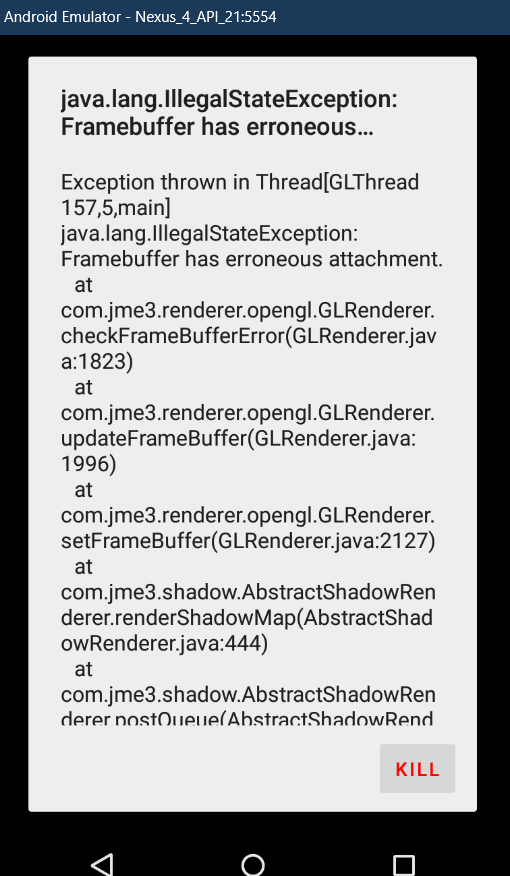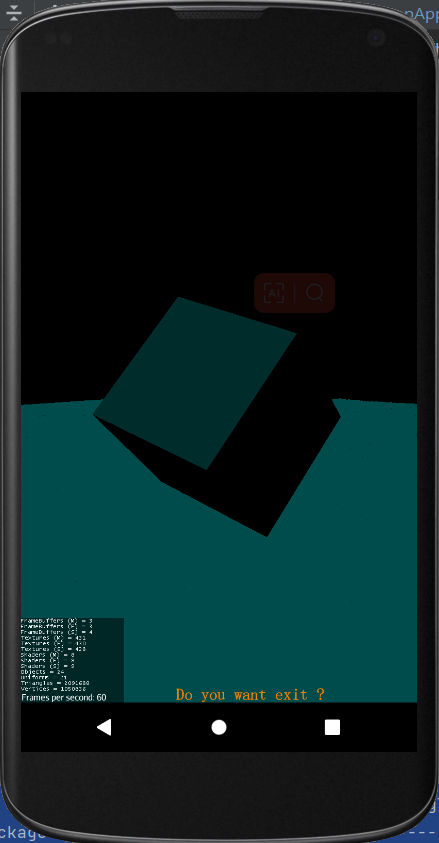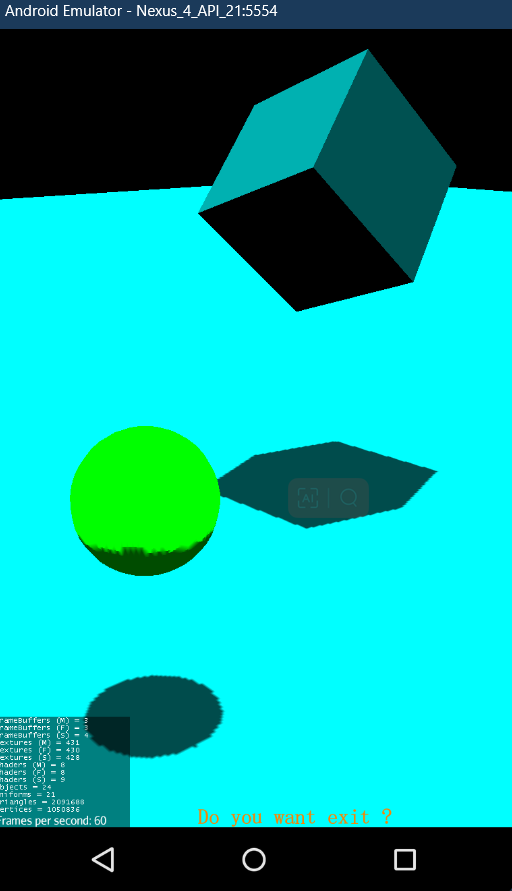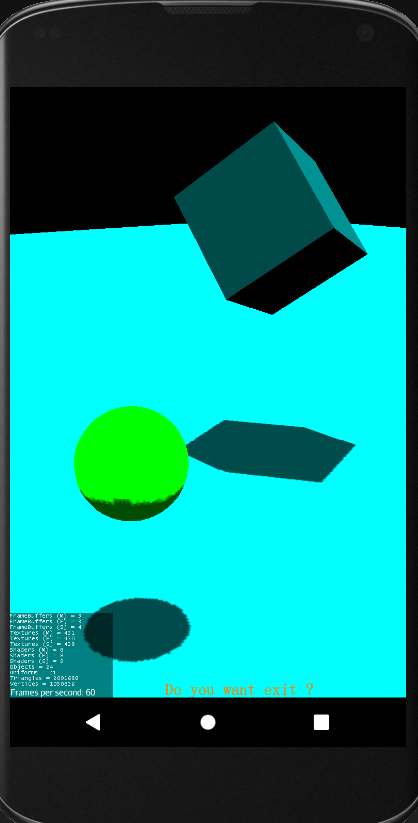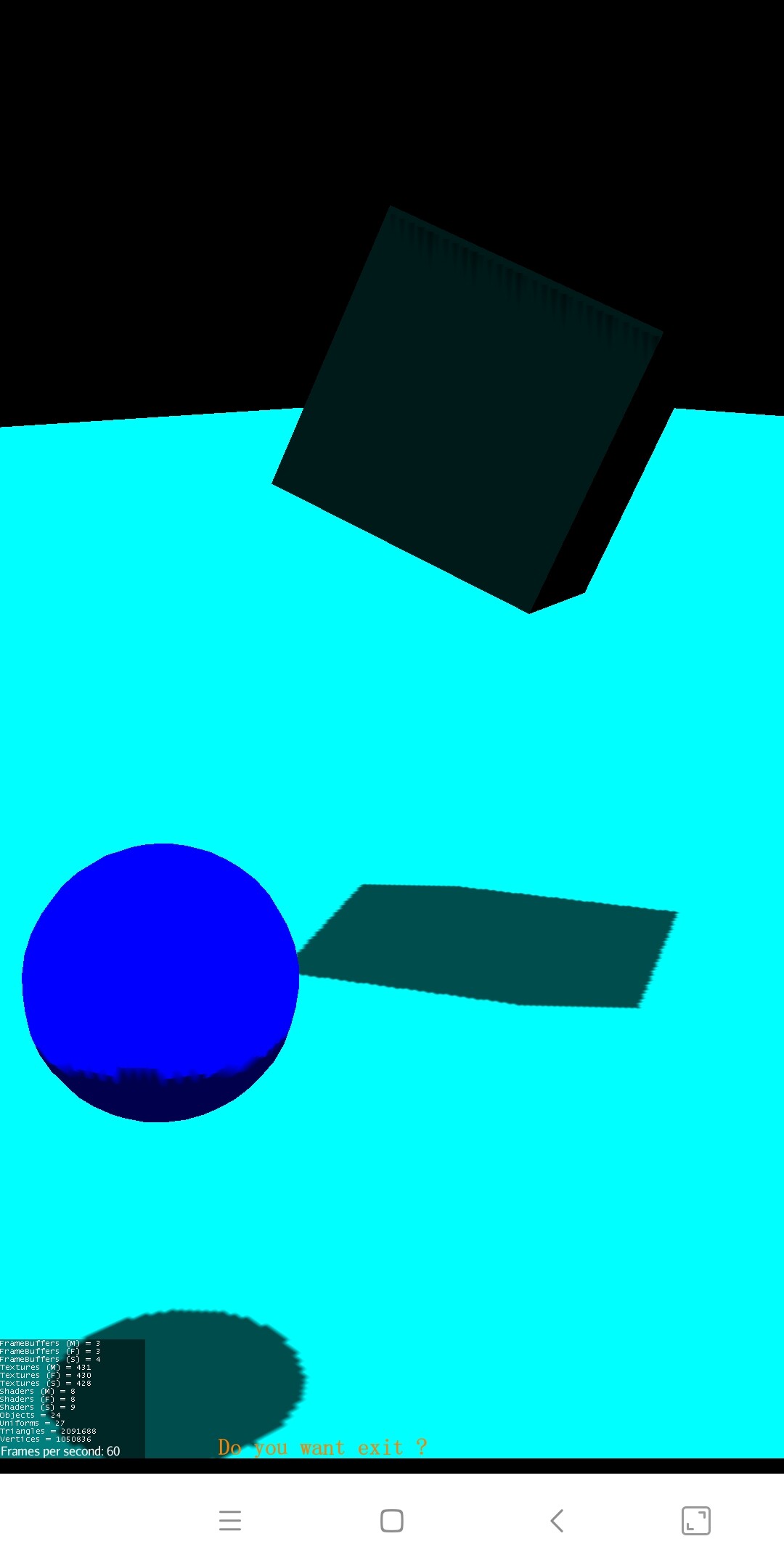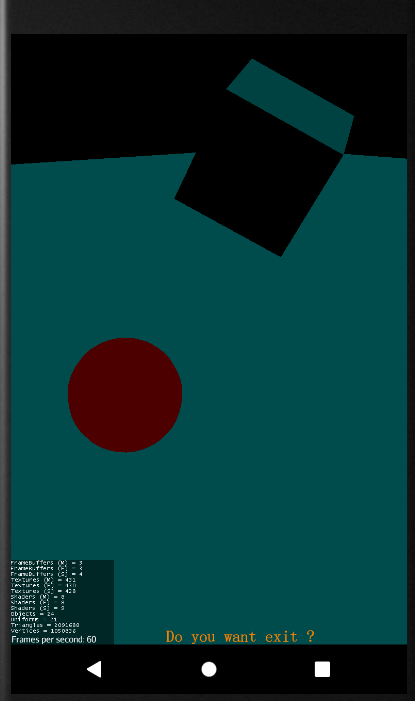First thing first, to save your time:
- There may be a bug in Lighting-Shadow with GLES2.
- AppSetting.setRenderer() failed to work.
- Android Studio Emulator should treated carefully in setting—>advanced—>ES api level
After resolved this problem, I experienced several new weirder issues.
With Unshaded.j3md it is ok, when changed to use Light with ShadowRenderer it failed on api 21 and passed on api 31.
INFO OpenGL Renderer Information
* Vendor: Google (ATI Technologies Inc.)
* Renderer: Android Emulator OpenGL ES Translator (AMD Radeon(TM) Vega 8 Graphics )
* OpenGL Version: OpenGL ES 2.0 (4.5.0 Core Profile Context 22.20.27.07.221020)
* GLSL Version: OpenGL ES GLSL ES 1.0.17
* Profile: Compatibility
WARNING Cannot find loader com.jme3.cursors.plugins.CursorLoader <------?
WARNING Cannot find loader com.jme3.audio.plugins.OGGLoader <------?
SEVERE Exception thrown in Thread[GLThread 157,5,main]
java.lang.IllegalStateException: Framebuffer has erroneous attachment.
at com.jme3.renderer.opengl.GLRenderer.checkFrameBufferError(GLRenderer.java:1823)
at com.jme3.renderer.opengl.GLRenderer.updateFrameBuffer(GLRenderer.java:1996)
at com.jme3.renderer.opengl.GLRenderer.setFrameBuffer(GLRenderer.java:2127)
at com.jme3.shadow.AbstractShadowRenderer.renderShadowMap(AbstractShadowRenderer.java:444)
at com.jme3.shadow.AbstractShadowRenderer.postQueue(AbstractShadowRenderer.java:422)
at com.jme3.renderer.RenderManager.renderViewPort(RenderManager.java:1216)
at com.jme3.renderer.RenderManager.render(RenderManager.java:1287)
at com.jme3.app.SimpleApplication.update(SimpleApplication.java:278)
at com.jme3.app.AndroidHarness.update(AndroidHarness.java:505)
at com.jme3.system.android.OGLESContext.onDrawFrame(OGLESContext.java:365)
at android.opengl.GLSurfaceView$GLThread.guardedRun(GLSurfaceView.java:1522)
at android.opengl.GLSurfaceView$GLThread.run(GLSurfaceView.java:1239)
eglMakeCurrent: 0x7f4a9ec3e200: ver 2 0 (tinfo 0x7f4a9ec2c180)
api 31 succesfully init, but looks darker and there is no shadow at all!
Then, I tried to change Android Studio Emulator settings, setting—>advanced—>ES api level from ‘autoselect’ to ‘renderer maximum’. Now, everything is fine.
So,
There may be a bug in Lighting-Shadow with GL2.
Android Studio Emulator should treated carefully.
=====parting line====
But
As a monkey of monkeys I am always want to know …WHY!? ![]()
So, another 3 hour spend. ![]()
Program never changed, so it may be GL related. To figure out the exact GL version our shader is running on, I decided to use a custom material.
.j3me
Technique {
VertexShader GLSL430 GLSL420 GLSL410 GLSL400 GLSL330 GLSL320 GLSL310 GLSL300 GLSL100 GLSL150: MatDefs/custom.vert
FragmentShader GLSL430 GLSL420 GLSL410 GLSL400 GLSL330 GLSL320 GLSL310 GLSL300 GLSL100 GLSL150: MatDefs/custom.frag
.frag
...
#import "Common/ShaderLib/GLSLCompat.glsllib" <-----------------------THIS IS IMPORTANT !!!
//cw_colorName use same value in JME3: const vec4 cw_Red = vec4(1.0, 0.0, 0.0, 1.0) etc.
void main(){
vec4 color = vec4(0.5);
// ES 100=2.0 300=3.0 310=3.1 320 =3.2
#if __VERSION__ == 100
gl_FragColor = cw_Red;
#else
#if __VERSION__ == 300
gl_FragColor = cw_Blue;
#else
#if __VERSION__ == 310
gl_FragColor = cw_Green;
#else
#if __VERSION__ == 320
gl_FragColor = cw_Yellow;
#else
//GL 110=2.0 120=2.1 130=3.0 140=3.1 150=3.2 330=3.3 400=4.0 410=4.1 420=4.2 430=4.3
#if __VERSION__ == 110
gl_FragColor = cw_Red;
#else
#if __VERSION__ == 120
gl_FragColor = cw_Orange;
#else
#if __VERSION__ == 130
gl_FragColor = cw_Blue;
#else
#if __VERSION__ == 140
gl_FragColor = cw_Green;
#else
#if __VERSION__ == 150
gl_FragColor = cw_Yellow;
#else
#if __VERSION__ == 330
gl_FragColor = cw_Brown;
#else
#if __VERSION__ == 400
gl_FragColor = cw_Magenta;
#else
#if __VERSION__ == 410
gl_FragColor = cw_Pink;
#else
#if __VERSION__ == 420
gl_FragColor = cw_Cyan;
#else
#if __VERSION__ == 430
gl_FragColor = cw_White;
#else
gl_FragColor = color;
...
Scene and material:
Material mat1 = new Material(app.getAssetManager(), "MatDefs/custom.j3md");
Material mat2 = new Material(app.getAssetManager(), "Common/MatDefs/Light/Lighting.j3md");
mat2.setBoolean("UseMaterialColors",true);
mat2.setColor("Diffuse", ColorRGBA.Cyan ); // with Lighting.j3md
mat2.setColor("Ambient", ColorRGBA.Pink );
geomBox.setMaterial(mat2);
surface.setMaterial(mat2);
geomSphere.setMaterial(mat1);
surface.move(1,1,5);
geomSphere.move(3,3,7);
geomBox.move(7f,7f,9f);
sun = new DirectionalLight();
sun.setColor(ColorRGBA.White);
((DirectionalLight)sun).setDirection(new Vector3f(0f,0f,-5f).normalizeLocal());
app.getRootNode().addLight(sun);
int shadlesize = 2048;
DirectionalLightShadowRenderer dlsr = new DirectionalLightShadowRenderer(app.getAssetManager(), shadlesize,3);
dlsr.setLight((DirectionalLight)sun);
app.getViewPort().addProcessor(dlsr);
app.getRootNode().setShadowMode(RenderQueue.ShadowMode.CastAndReceive);
For comparison purpose, a desktop application is designed with the same core module (SimpleApplication.class ) that android app used:
AppSettings set = new AppSettings(false);
set.setFullscreen(false);
set.setRenderer(AppSettings.LWJGL_OPENGL33); <------- remember this
app.setSettings(set);
ok, here comes the debug sheet:
Setting: Emulator GLES3.1, desktop GL3.3.
API 21:
API 31:
Desktop:
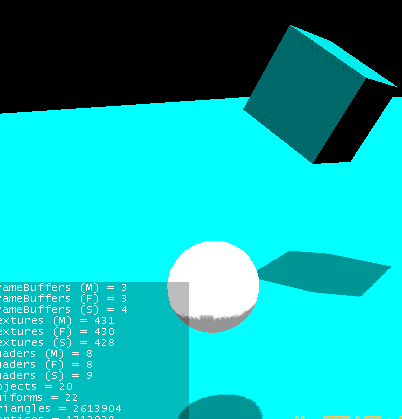
Physical device API 29:
Physical device API 23:
The color of the Sphere:
Green = GLES 3.1 Blue = GLES 3.0
(Since there is no Yellow, so these are the system GL version)
White = GL 4.3
(This is the GL version system can support)
Now, set Emulator back to Compatibility or autoselect.
API 31:
API 21:
failed to init.
Untill now, I’m pretty much sure there is an issue in shadow system on GL2. Curiosity fulfilled.
Wait a minute!
Didn’t I set AppSetting.setRenderer(AppSettings.LWJGL_OPENGL33) ???
Shouldn’t a Brown sphere appeared instead of a White one ?
White means the shader is running on GLSL430 and GL version is at least 4.3.
OK, let’s test all combinations:
AppSettings.LWJGL_OPENGL2 : passed. white sphere.
AppSettings.LWJGL_OPENGL30: failed.
AppSettings.LWJGL_OPENGL31: failed.
AppSettings.LWJGL_OPENGL32: passed. white sphere.
AppSettings.LWJGL_OPENGL33: passed. white sphere.
AppSettings.LWJGL_OPENGL40-45: passed. white sphere.
Error message:
com.jme3.system.JmeDesktopSystem initialize
: Running on jMonkeyEngine 3.6.0-stable
* Branch: HEAD
* Git Hash: 53f2a49
* Build Date: 2023-03-20
com.jme3.app.LegacyApplication handleError
: Context profiles are only defined for OpenGL version 3.2 and above
java.lang.Exception: Context profiles are only defined for OpenGL version 3.2 and above
at com.jme3.system.lwjgl.LwjglWindow$1.invoke(LwjglWindow.java:229)
at org.lwjgl.glfw.GLFWErrorCallbackI.callback(GLFWErrorCallbackI.java:43)
at org.lwjgl.system.JNI.invokePPPP(Native Method)
at org.lwjgl.glfw.GLFW.nglfwCreateWindow(GLFW.java:2024)
at org.lwjgl.glfw.GLFW.glfwCreateWindow(GLFW.java:2197)
at com.jme3.system.lwjgl.LwjglWindow.createContext(LwjglWindow.java:294)
at com.jme3.system.lwjgl.LwjglWindow.initInThread(LwjglWindow.java:582)
at com.jme3.system.lwjgl.LwjglWindow.run(LwjglWindow.java:704)
at java.base/java.lang.Thread.run(Thread.java:833)
com.jme3.system.JmeSystemDelegate lambda$new$0
: JmeDialogsFactory implementation not found.
Context profiles are only defined for OpenGL version 3.2 and above
Exception: Context profiles are only defined for OpenGL version 3.2 and above
com.jme3.app.LegacyApplication handleError
: Failed to create display
java.lang.RuntimeException: Failed to create the GLFW window
at com.jme3.system.lwjgl.LwjglWindow.createContext(LwjglWindow.java:296)
at com.jme3.system.lwjgl.LwjglWindow.initInThread(LwjglWindow.java:582)
at com.jme3.system.lwjgl.LwjglWindow.run(LwjglWindow.java:704)
at java.base/java.lang.Thread.run(Thread.java:833)
com.jme3.system.JmeSystemDelegate lambda$new$0
: JmeDialogsFactory implementation not found.
Failed to create display
RuntimeException: Failed to create the GLFW window
com.jme3.system.lwjgl.LwjglWindow run
: Display initialization failed. Cannot continue.
6:52:56: Execution finished ':desktop:DesktopApp.main()'.
Conclusion:
AppSetting.setRenderer has bugs.
====finish line====
thanks for your reading here, have a gooood day ![]()
[EDIT]
Well, Filter has material internally. pls, ignore BTW part~~~
BTW:
The custom j3me do not contain any shadow Technique yet it can still cast shadow.
Is this mean shadow will use inPosition and we’d better do not reuse ‘attribute vec3 inPosition’ when we link custom objs to shadow inherence tree?
